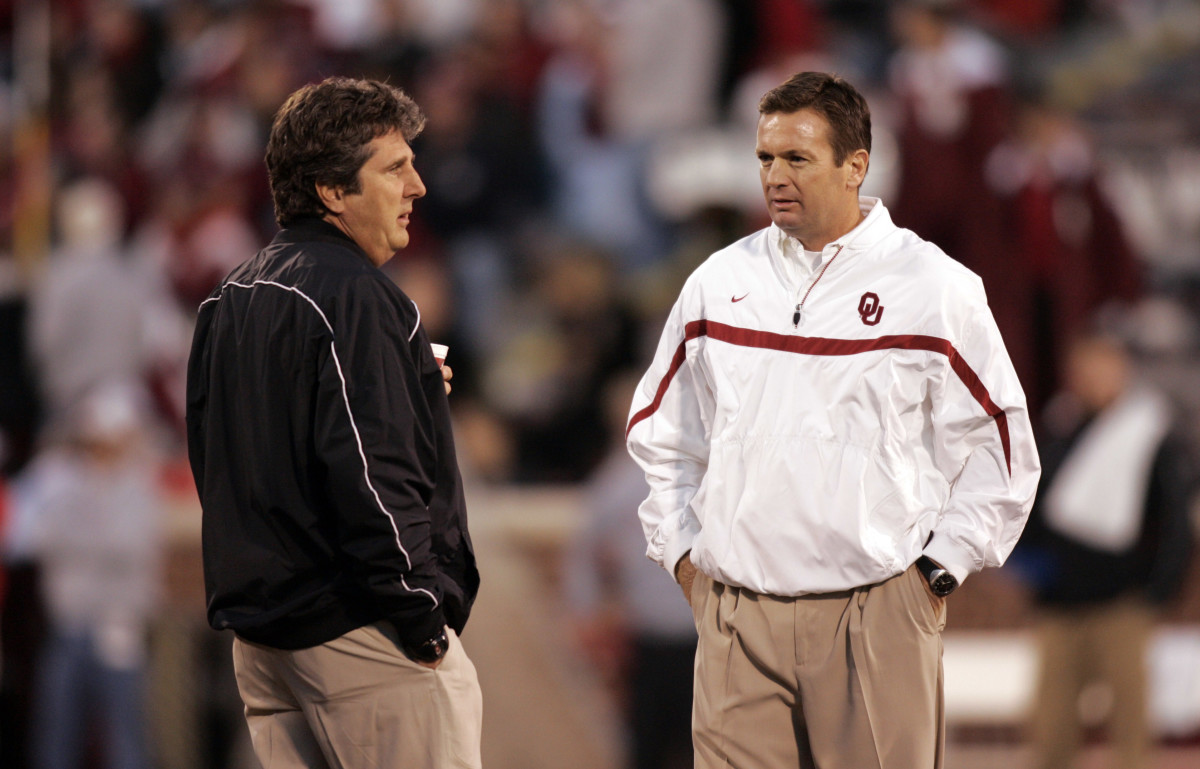COLUMN: How Mike Leach Permanently Changed Oklahoma's Culture, and More
What kind of impact could one assistant coach have made at a college football giant like Oklahoma in just one year?
If that assistant was Mike Leach, then the impact is incalculable — and, almost a quarter century later, ongoing.
Leach, 61, reportedly fell victim to a massive heart attack on Sunday and tragically died Monday. Friends and colleagues are lauding Leach for his unique personalty — quirky and irreverent, funny, but from an oddball perspective. His press conference persona almost became its own cottage industry for endless online giggles.
But it needs to be emphasized what a brilliant football mind Leach was.
RIP Mike my friend, you’ll always be cherished by Sooner Nation! Love and peace to Sharon and your children. pic.twitter.com/BunOTeLuTC
— Bob Stoops (@CoachBobStoops) December 13, 2022
Leach’s formative years in football were spent at the table of BYU legend and offensive savant LaVell Edwards. Among the Cougars’ quarterbacks during Leach’s time in Provo were Marc Wilson, Jim McMahon and Steve Young.
Leach earned his bachelor’s degree from BYU and received a Juris Doctor from Pepperdine. In 1987, he got into coaching full-time and began to spread his unique football insights.
He joined Hal Mumme’s staff at Iowa Wesleyan in 1989. It was the pairing with Mumme that produced vintage Leach: three years in Iowa, five years in Georgia at Valdosta State, then two years at Kentucky, turning Wildcat football into a form of basketball on grass.
The duo hatched their “air raid” offense on Division I football, and the results can be seen at virtually every level of the game today, from youth league to high school to college and even in the NFL.
It was still Mumme calling the plays, but Leach’s input on their innovations at Kentucky popularized the spread, made UK quarterback Tim Couch the No. 1 pick in the draft and ensured Leach would have an indelible legacy in the sport.
The synchronicity of Leach and Mumme crossing paths with Bob Stoops in 1997 and ’98 — at just the right time in college football history — became the stuff of legend.
Stoops had created a monster as Kansas State’s defensive coordinator under Bill Snyder. In three seasons under Steve Spurrier at Florida, Stoops plied that monsterous defense into a national championship.
Stoops has famously told the story many times that when he got the head coaching job at Oklahoma and needed to hire an offensive coordinator, he asked himself who was it that had given him the most problems at Florida.

The Wildcats scored 28 points against Stoops’ Gator defense in 1997 in a 55-28 loss, and scored 35 in 1998 in a 51-35 loss. Those were staggering results against a Gators defense that gave up just 16.1 points per game against everyone else in 1997 and 11.8 in 1998.
“I knew I couldn’t hire Hal, he was the head coach,” Stoops said Tuesday during an interview with Toby Rowland on KREF in Norman. “But I wanted the offense. I asked Hal, I said, ‘Can Mike do what you do?’ Because Mike was his protégée. He was always with him. I knew Hal called the plays. And to me, that mattered. He said, ‘Oh, absolutely.’ ‘Could he be the leader in front of the offense?’ And he said, ‘Absolutely.’ So that was what I wanted to do.”
Under Stoops, with Mike Stoops and Brent Venables as his co-defensive coordinators and Leach as his offensive coordinator, Oklahoma turned around five years of losing and mediocrity and produced a 7-5 record in 1999.
Not great, but sustainiable. Not perfect, but lasting.
Leach’s immediate impact was on offensive production, but more than that, he recruited Josh Heupel out of Snow Junior College — Heupel’s official visit was simply a two-day marathon film session, entrenched in a dark room with Leach — and the savvy left-hander led OU to the national championship a year later.
Leach also recruited 2002 Rose Bowl MVP Nate Hybl as a transfer from Georgia. He also recruited Tuttle product and 2003 Heisman Trophy winner Jason White, who played in two national championship games.
“He had a huge impact on us at OU in that first signing class,” Stoops said, “with Josh Heupel, Nate Hybl and Jason White.”
Leach didn’t get to enjoy the fruits of the air raid seeds he planted. He took the head coaching job at Texas Tech after just one season in Norman and rebuilt that program in his own quirky but infinitely prolific image.
Even though Leach’s tenure in crimson and cream lasted less than 12 months, it simply can’t be overstated how permanent his fingerprints became during his short time at Oklahoma.
Without Leach, OU would have never landed Heupel. Without Heupel, Stoops might have had to wait a long, long time to win his national championship. Without that 13-0 season in year two of the Stoops era, the entire OU athletic department would be significantly lesser today.
The 2000 title restored optimism at Oklahoma and brought a level of donor generosity that hadn’t been seen at OU — ever. That money ignited a building boom that elevated not only every athletic facility on campus, but various academic and residential facilities as well.
And of course, as Stoops handed the offense to Mark Mangino, Chuck Long, Kevin Wilson and eventually Heupel, the Sooner offense maintained elements of Leach’s air raid concepts. Heupel’s successor was Lincoln Riley, who studied under Leach himself at Texas Tech. Even today, Jeff Lebby’s offense stems from Art Briles at Baylor. Briles, too, was a Leach disciple at Tech.
Now, with luminaries like White, Sam Bradford, Landry Jones, Baker Mayfield, Kyler Murray, Jalen Hurts and Caleb Williams, Oklahoma lays claim to being “QBU.”
Leach’s enduring legacy as an offensive innovator — directing a scheme that fits on an 8 1/2 by 11 inch piece of paper on gamedays and is infinitely quarterback-friendly — is one thing.
But doing it at a place like Oklahoma is even more mind-blowing. For seven decades, OU’s DNA was running the football, pounding away on the ground, grinding defenses down to a nub with a relentless running game built on both power and speed.
Since the days of Bennie Owen, through the Split-T dynasty of Bud Wilkinson, and in and out of the wishbone wizardry of Barry Switzer, generations of Sooner Nation knew only how to run the ball. Like today’s service academies, throwing the football at OU used to be an oddity, a desperate gambit, a one-off.
Maybe Switzer would have successfully shifted to an aerial offense if Troy Aikman had stayed healthy — and if his rogue players hadn’t gotten him fired. Who can say for sure?
But even after Switzer left, whether it was Gary Gibbs or Howard Schnellenberger or John Blake trying unsuccessfully to change the culture and establish the forward pass, the Sooner offenses of the 1990s almost inevitably resorted to having to run the football — mostly because they couldn’t throw it.
Even after Leach arrived and proved it was possible to win in Norman with big passing numbers, many fans resisted.
“We’d win more if we went back to the wishbone,” was a common complaint on sports talk radio during the ’99 season.
Now, OU is considered the vanguard of offensive football. In an industry that is inherently transient, Mike Leach’s imprint will be permanent.
“Mike,” said Stoops, “was huge.”
